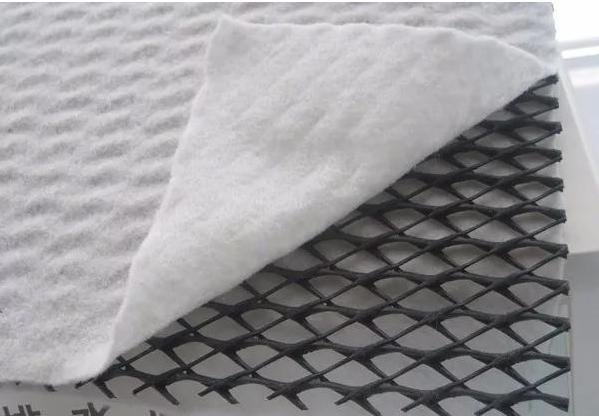Using high-density polyethylene as raw material, the ribs are extruded through a special machine head, and the three ribs are arranged at a certain distance and angle to form a three-dimensional space structure with drainage channels. The middle rib has greater rigidity and forms a rectangular drainage channel. The three layers of ribs that make up the drainage network have high vertical and horizontal tensile strength and compressive strength. The drainage channel formed between the three layers of ribs is not easy to deform under high load, which can prevent the geotextile from being embedded in the geonet core and ensure smooth drainage. , The three-dimensional geotechnical drainage network has high-strength and high-conducting type according to the purpose.

Product Specifications
Mesh core thickness: 5mm~8mm; width 2~4m, length according to user requirements.
Features
1. Strong drainage (equivalent to one meter thick gravel drainage).
2. High tensile strength.
3. Reduce the probability of geotextiles embedded in the mesh core and maintain long-term stable drainage.
4. Long-term withstand high pressure load (can withstand a compressive load of about 3000Ka).
5. Corrosion resistance, acid and alkali resistance, long service life.
6. The construction is convenient, the construction period is shortened, and the cost is reduced.
Main application performance
1. It is laid between the foundation and the sub-base to drain the accumulated water between the foundation and the sub-base, block the capillary water and effectively combine it into the edge drainage system. This structure automatically shortens the drainage path of the foundation, the drainage time is greatly reduced, and the amount of selected foundation material can be reduced (ie, the material with more fines and lower permeability can be used). Extend the life of the road.
2. Laying a three-dimensional composite drainage net on the sub-base can prevent the fine material of the sub-base from entering the base (that is, it plays a role in isolation). The aggregate base layer will enter the upper part of the geonet to a limited extent. It also has the potential to limit the lateral movement of the aggregate base, in this way it acts like the reinforcement of a geogrid. Generally speaking, the tensile strength and rigidity of the three-dimensional composite drainage net are better than that of many geogrids used for foundation reinforcement, and this restriction will improve the support capacity of the foundation.
3. After the road ages and cracks are formed, most of the rainwater will enter the section. In this case, the three-dimensional composite drainage net is laid directly under the road surface instead of the drainable foundation. The three-dimensional composite drainage mesh can collect moisture before it enters the foundation/subbase. Moreover, the bottom end of the three-dimensional composite drainage net can be wrapped with a layer of film to further prevent moisture from entering the foundation. For rigid road systems, this structure allows the road to be designed with a higher drainage coefficient Cd. Another advantage of this structure is the possibility of more uniform hydration of the concrete (studies on the extent of this advantage are ongoing). Whether for rigid road or flexible road systems, this structure can extend the service life of the road.
4. In northern climate conditions, laying a three-dimensional composite drainage network can help reduce the impact of frost heave. If the freezing depth is deep, the geonet can be laid at a shallower position in the sub-base to act as a capillary blockage. It is also often necessary to replace it with a granular subbase that is less prone to frost heave, extending down to freezing depths. The backfill soil that is easy to frost heave can be directly filled on the three-dimensional composite drainage network until the ground line. In this case, the system can be connected to a drain outlet so that the water table is at or below this depth. This could potentially limit the development of ice crystals without limiting traffic loads when ice melts in spring in cold regions.
Scope of application
Landfill drainage, highway subgrade and pavement drainage, railway drainage, tunnel drainage, underground structure drainage, retaining wall back drainage, garden and sports ground drainage.
Seams and laps
1. The adjustment of the direction of the geosynthetic material, the vertical roll length of the material is on the way.
2. The composite geotechnical drainage net must be connected to the adjacent geonet, and the geosynthetic core roller should be along the joint.
3. The white or yellow color of the plastic buckle or polymer is connected with the adjacent Hongxiang geomaterial volume of the geonet core, thereby connecting the material roll. Attach a belt every 3 feet along the length of the roll of material.
4. Overlapping fabrics and packaging in the same direction as the stacking direction. If the geotextile between the foundation, base and sub-base is laid, continuous welding, wedge welding or stitching shall be carried out to make up
The geotextile layer can be fixed. If sutured, the use of a cover stitch or general suture method is recommended to achieve the minimum loop length requirements.
Post time: Feb-28-2023





